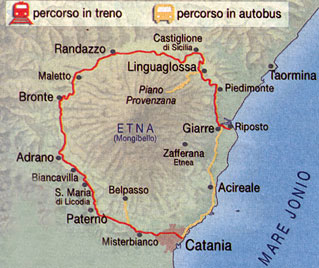 The realization of the railway that, going around mount Etna, was connecting Bronte with Catania and Giarre, was for the town an event of historical importance. The realization of the railway that, going around mount Etna, was connecting Bronte with Catania and Giarre, was for the town an event of historical importance.
Was finally taken away from isolation a town of about 20.000 inhabitants, economically developed and with a prestigious college, the Real Capizzi college, which was lodging several Sicilian and Calabrian students (the boarders at that time reached the number of over three hundred ). The brontese folks, the relatives of the boarding school students which normally came to Bronte, were forced to weary journeys on carriages or mule back to reach Catania or Giarre. The commercialization and transport of the brontese products (pistachio, wine, almonds, cereals, whit and oil) toward Giarre o Catania was carried out travelling for over a day with small carts pulled by mules or horses, over terrible mountain roads with the added danger of being robbed of everything by the many bandits that infested the zone. The railway was bringing wealth and releasing from isolation a country of 20.000 inhabitants with an agricultural very thriving economy, but his realization was long and tormented. The idea of realizing a railway around Etna was born with the constitution of a Consortium Between Catania and the piedmont countries, stipulated with the Royal Decree of December 31st, 1883. The first deliberation of our Civic Council regarding the building of the railway goes to January 9th, 1882: Was establishing that the station in Bronte Of The Circum-etnea did not have to be distant more than 500 meters from the habitat and that the quotes of contribution for all the associated councils "must not exceed L. 60.000 for fifty years". A year later, on February 22, 1883, the same Council accepted the distribution of the shares done by the Provincial Deputation, which for our council was amounting at L. 5.174,10. Two years later, on April 7, 1884, the Civic Council, "knowing that good part of the population wanted the station of the Circumetnea to rise in Pietra Pizzuta district, below the old theatre, downstream of the habitat", decides to change the initial project moving, the station in the next district "Carcere Bovi". Again two years later, the Council, with a deliberation of 23 January 1886, names the baron Enrico Grimaldi- Serravalle of the company Circumetnea representative of the Council. The hopes of the brontese citizens to have the station "near house" however were disappointed. Lively protests were raised, 26 October 1889, from the Civic Council against the concessionary company than with a new layout, established unilaterally, was placing the station upstream to a distance of about three kilometers from Bronte. The concessionary company, pursuing only its economic interests, realized upstream (on the current place) the way and the station, very far from the habitat. The first railway section inaugurated on February 2nd, 1895, was the "Catania Borgo-Adernò", "qualified for everybody indistinctly the transport travelers, luggage and dogs, goods to big and little speed, vehicles and cattle". The Aderno-Bronte stroke was inaugurated on June 2 of 1895; the station in Bronte was built, very far from the lived center, in the high part of the town. The Council, to make the marketing of the brontese products easier, was forced to a further expense of lire 50.000 to connect the station of the Circum "with a new road suitable for carriages". |